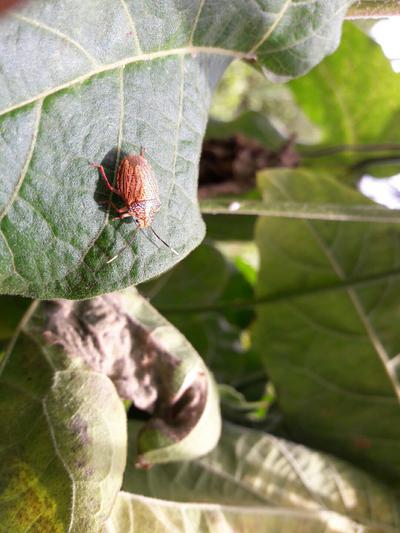Brown Stink Bug
Euschistus servus
Insect
In a Nutshell
- Stained bolls.
- Shrunken seeds.
- Young bolls drop off.
- Wart like growths.
- Reduced yield quantity and quality.
- Broad, shield-shaped bodies, brown colored bugs.
Can also be found in
Symptoms
Stink bugs feed on the squares and bolls of cotton. They attack mainly older bolls which then are stained and matted superficially. Seeds of the attacked bolls are shriveled and bolls may not open. If young bolls are damaged, they may drop off. The external lesions are associated with wart like growths on the interior of the boll, more precisely on the inner carpal wall where penetration has occurred. Seed feeding may result in reduced cotton production and stained cotton near the feeding site, which is a clear loss in terms of quality. Stink bugs are also known to facilitate the infection of opportunistic boll rotting organisms.
Recommendations

Organic Control
Parasitic tachinid flies and wasps lay eggs into the eggs of stink bugs and their larvae later feed on the hatching maggots. Birds and spiders can also help to reduce infestation. The oil of Eucalyptus urograndis is toxic to the bugs and their nymphs.

Chemical Control
Always consider an integrated approach with preventive measures together with biological treatments if available. Seed treatments with insecticides of the pyrethroids group may provide some control and avoid damage in seedlings. Foliar application of insecticides based on dicrotophos and bifenthrin can also help to control populations.
What caused it?
Adults overwinter in protected areas such as ditch banks, fence rows, under boards and dead weeds, ground cover, stones, and under the bark of trees. They become active during the first warm days of spring when temperatures rise above 21°C. Normally the first generation develops on wild hosts, while the second generation typically develops on cultivated crops. Each female lays about 18 egg masses, averaging 60 eggs, over a period of over 100 days. Adults are strong fliers and will readily move between weeds and other alternate hosts.
Preventive Measures
- Plant early to avoid peak populations.
- Monitor the fields regularly for signs of the pest.
- Make sure to rogue the weeds from the field.
- Barriers between fields can help to reduce the migrations of the bug.
- Clear the field of plant residues after harvesting.
- No-tillage practices or the presence of mulch favors the risk of infestation.



